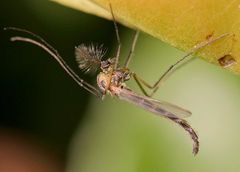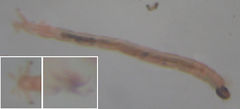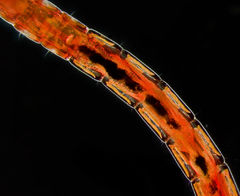Chironomidae
| Chironomidae | |
|---|---|
 |
|
| Chironomus plumosus | |
| Scientific classification | |
| Kingdom: | Animalia |
| Phylum: | Arthropoda |
| Class: | Insecta |
| Order: | Diptera |
| Suborder: | Nematocera |
| Infraorder: | Culicomorpha |
| Superfamily: | Chironomoidea |
| Family: | Chironomidae |
| Genera | |
|
See text |
|


Chironomidae (informally known as chironomids or non-biting midges) are a family of nematoceran flies with a global distribution. They are closely related to the Ceratopogonidae, Simuliidae, and Thaumaleidae. Many species superficially resemble mosquitoes but they lack the wing scales and elongate mouthparts of the Culicidae. This is a large group of insects with over 5000 described species and 700 species in North America alone. Males are easily recognized by their plumose antennae. Adults are sometimes known as "lake flies" in parts of Canada, as "sand flies", "muckleheads",[1] or "muffleheads"[2] in various regions of the USA Great Lakes area, and as "blind mosquitoes" or "chizzywinks" in Florida, USA[3].
Contents |
Behavior and description
Larvae can be found in almost any aquatic or semiaquatic habitat, including treeholes, bromeliads, rotting vegetation, soil, and in sewage and artificial containers. Larvae of some species are bright red in color due to a hemoglobin analog; these are often known as "bloodworms".[4]
Adults can be pests when they emerge in large numbers. They can damage paint, brick, and other surfaces with their droppings. When large numbers of adults die they can build up into malodorous piles. They can provoke allergic reactions in sensitive individuals.[5]
Ecology
Larvae and pupae are important as food items for fish such as trout and other aquatic organisms. The flying midges themselves are also eaten by fish, and insectivorous birds such as swallows and martins. The larvae are consumed by certain amphibians, such as the rough-skinned newt.[6] They are also used by fly anglers, who design and tie imitators to catch trout.
They are also important as indicator organisms, i.e., the presence, absence, or quantities of various species in a given body of water can indicate whether pollutants may be present. Their fossils are also widely used by palaeolimnologists as indicators of past environmental changes, including past climatic changes.[7]
Subfamilies and genera
The family is divided into eleven subfamilies: Aphroteniinae, Buchonomyiinae, Chilenomyinae, Chironominae, Diamesinae, Orthocladiinae, Podonominae, Prodiamesinae, Tanypodinae, Telmatogetoninae, Usambaromyiinae.[8][9]
|
|
|
References
- ↑ "Muckleheads" from Andre's Weather World (Andre Bernier, staff at WJW-TV), June 2, 2007.
- ↑ "You don't love muffleheads, but Lake Erie does", Sandusky Register, May 29, 2007.
- ↑ "Chizzywinks are Blind Mosquitos by Dan Culbert of the University of Florida, August 17, 2005
- ↑ W.P. Coffman and L.C. Ferrington, Jr. 1996. Chironomidae. pp. 635-754. In: R.W. Merritt and K.W. Cummins, eds. An Introduction to the Aquatic Insects of North America. Kendall/Hunt Publishing Company.
- ↑ A. Ali. 1991. Perspectives on management of pestiferous Chironomidae (Diptera), an emerging global problem. Journal of the American Mosquito Control Association 7: 260-281.
- ↑ C. Michael Hogan (2008) Rough-skinned Newt (Taricha granulosa), Globaltwitcher, ed. Nicklas Stromberg [1]
- ↑ Walker, I. R. 2001. Midges: Chironomidae and related Diptera. pp. 43-66, In: J. P. Smol, H. J. B. Birks, and W. M. Last (eds). Tracking Environmental Change Using Lake Sediments. Volume 4. Zoological Indicators. Kluwer Academic Publishers, Dordrecht.
- ↑ J.H. Epler. 2001. Identification manual for the larval Chironomidae (Diptera) of North and South Carolina. North Carolina Department of Environment and Natural Resources.
- ↑ Armitage, P., Cranston, P.S., and Pinder, L.C.V. (eds.) (1994) The Chironomidae: Biology and Ecology of Non-biting Midges. Chapman and Hall, London, 572 pp.
- ↑ [|Ekrem, Torbjørn]. "Systematics and biogeography of Zavrelia, Afrozavrelia and Stempellinella (Diptera: Chironomidae)". http://folk.ntnu.no/torbjoe/Stempellinella&Zavrelia/index.htm. Retrieved 2009-04-30.
- ↑ Makarchenko, Eugenyi A. (2005). "A new species of Arctodiamesa Makarchenko (Diptera: Chironomidae: Diamesinae) from the Russian Far East, with a key to known species of the genus" (PDF). Zootaxa (New Zealand: Magnolia Press) 1084: 59–64. ISSN 1175-5334. http://ibss.febras.ru/files/00002385.pdf. Retrieved 2009-04-03.
- ↑ Caldwell, Broughton A.; Soponis, Annelle R. (1982). "Hudsonimyia Parrishi, a New Species of Tanypodinae (Diptera: Chironomidae) from Georgia" (PDF). The Florida Entomologist (Lutz, FL, USA: Florida Entomological Society) 65 (4): 506–513. doi:10.2307/3494686. ISSN 0015-4040. http://fulltext10.fcla.edu/DLData/SN/SN00154040/0065_004/98p0290n.pdf. Retrieved 2009-04-20.
- ↑ Halvorsen, Godtfred A. (1982). "Saetheriella amplicristata gen. n., sp. n., a new Orthocladiinae (Diptera: Chironomidae) from Tennessee". Aquatic Insects, International Journal of Freshwater Entomology (Taylor & Francis) 4 (3): 131–136. doi:10.1080/01650428209361098. ISSN 1744-4152.
- ↑ Andersen, Trond; Sæther, Ole A. (January 1994). "Usambaromyia nigrala gen. n., sp. n., and Usambaromyiinae, a new subfamily among the Chironomidae (Diptera)". Aquatic Insects, International Journal of Freshwater Entomology (Taylor & Francis) 16 (1): 21–29. doi:10.1080/01650429409361531. ISSN 1744-4152.
External links
 Media related to Chironomidae at Wikimedia Commons
Media related to Chironomidae at Wikimedia Commons- The Chironomid Home Page
- Chironomidae and Water Beetles of Florida
- Chironomidae Research Group, University of Minnesota
- Family Chironomidae at Soil and Water Conservation Society of Metro Halifax
- Checklist of UK Recorded Chironomidae
- Chironomidae at Nomina Insecta Nearctica
- Chironomid Palaeoecology @ UBC Okanagan
- Chironomidae at Australian Faunal Directory
- hydrilla tip mining midge on the UF / IFAS Featured Creatures Web site
- Diptera.info Images